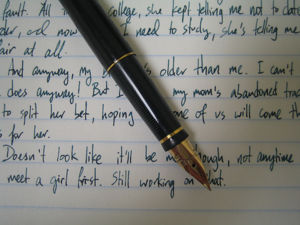Orthography: Difference between revisions
imported>John Stephenson (silly error on my part) |
imported>John Stephenson (clarification) |
||
| Line 1: | Line 1: | ||
{{subpages}} | {{subpages}} | ||
[[Image:Writing-pen-english.jpg|thumb|right|300px|[[written language|Written]] [[English language|English]] uses the [[Roman alphabet]] | [[Image:Writing-pen-english.jpg|thumb|right|300px|[[written language|Written]] [[English language|English]] uses the [[Roman alphabet]]. English writing consists of a [[morphophonology|morphophonemic]] [[alphabet]] with orthographic rules of [[spelling]] and [[punctuation]] distinct from other languages.]] | ||
'''Orthography''' refers to the rules for [[writing]] a [[language]], such as conventions of [[spelling]] and [[punctuation]], and also includes the [[grapheme]]-[[phoneme]] ([[letter (alphabet)|letter]]-sound) correspondences of [[alphabet]]ic scripts - the actual appearance of the symbols as letters, in this case. Sometimes ''[[writing system]]'' is defined in the same way, but this also has the meaning of a set of [[symbol|sign]]s used to write a language. For example, the Roman [[alphabet]] is a single script, but each language it is used for has a different orthography.<ref>Cook & Bassetti (2005: 2-3).</ref> Therefore it is appropriate to discuss 'English orthography' and '[[French language|French]] orthography' as different, though they use the same script. For example, both use the 'digraph' (two letters in combination) <ch>,<ref>Angle brackets indicate a letter of an alphabet.</ref> but in French it represents /ʃ/ as in ''chat'' 'cat' while in English it can be /tʃ/, /k/ or /ʃ/ as in ''church'', ''chemistry'' and ''champagne''. Orthography also covers differences between varieties of the same language, such as the presence or absence of <nowiki><u></nowiki> in words such as ''colour'' in [[British and American English]]. Some languages, such as [[Japanese language|Japanese]], use more than one kind of writing system in their overall written language system; in these cases, orthographic rules determine which system is used, e.g. for example, ''[[katakana]]'' (カタカナ) is typically used for words of recent [[loanword|foreign origin]], or to emphasise [[words]] or phrases. In English orthography, this is achieved by ''italics'', '''bold''' or CAPITAL letters. | '''Orthography''' refers to the rules for [[writing]] a [[language]], such as conventions of [[spelling]] and [[punctuation]], and also includes the [[grapheme]]-[[phoneme]] ([[letter (alphabet)|letter]]-sound) correspondences of [[alphabet]]ic scripts - the actual appearance of the symbols as letters, in this case. Sometimes ''[[writing system]]'' is defined in the same way, but this also has the meaning of a set of [[symbol|sign]]s used to write a language. For example, the Roman [[alphabet]] is a single script, but each language it is used for has a different orthography.<ref>Cook & Bassetti (2005: 2-3).</ref> Therefore it is appropriate to discuss 'English orthography' and '[[French language|French]] orthography' as different, though they use the same script. For example, both use the 'digraph' (two letters in combination) <ch>,<ref>Angle brackets indicate a letter of an alphabet.</ref> but in French it represents /ʃ/ as in ''chat'' 'cat' while in English it can be /tʃ/, /k/ or /ʃ/ as in ''church'', ''chemistry'' and ''champagne''. Orthography also covers differences between varieties of the same language, such as the presence or absence of <nowiki><u></nowiki> in words such as ''colour'' in [[British and American English]]. Some languages, such as [[Japanese language|Japanese]], use more than one kind of writing system in their overall written language system; in these cases, orthographic rules determine which system is used, e.g. for example, ''[[katakana]]'' (カタカナ) is typically used for words of recent [[loanword|foreign origin]], or to emphasise [[words]] or phrases. In English orthography, this is achieved by ''italics'', '''bold''' or CAPITAL letters. | ||
Revision as of 23:33, 5 June 2009

Orthography refers to the rules for writing a language, such as conventions of spelling and punctuation, and also includes the grapheme-phoneme (letter-sound) correspondences of alphabetic scripts - the actual appearance of the symbols as letters, in this case. Sometimes writing system is defined in the same way, but this also has the meaning of a set of signs used to write a language. For example, the Roman alphabet is a single script, but each language it is used for has a different orthography.[1] Therefore it is appropriate to discuss 'English orthography' and 'French orthography' as different, though they use the same script. For example, both use the 'digraph' (two letters in combination) <ch>,[2] but in French it represents /ʃ/ as in chat 'cat' while in English it can be /tʃ/, /k/ or /ʃ/ as in church, chemistry and champagne. Orthography also covers differences between varieties of the same language, such as the presence or absence of <u> in words such as colour in British and American English. Some languages, such as Japanese, use more than one kind of writing system in their overall written language system; in these cases, orthographic rules determine which system is used, e.g. for example, katakana (カタカナ) is typically used for words of recent foreign origin, or to emphasise words or phrases. In English orthography, this is achieved by italics, bold or CAPITAL letters.